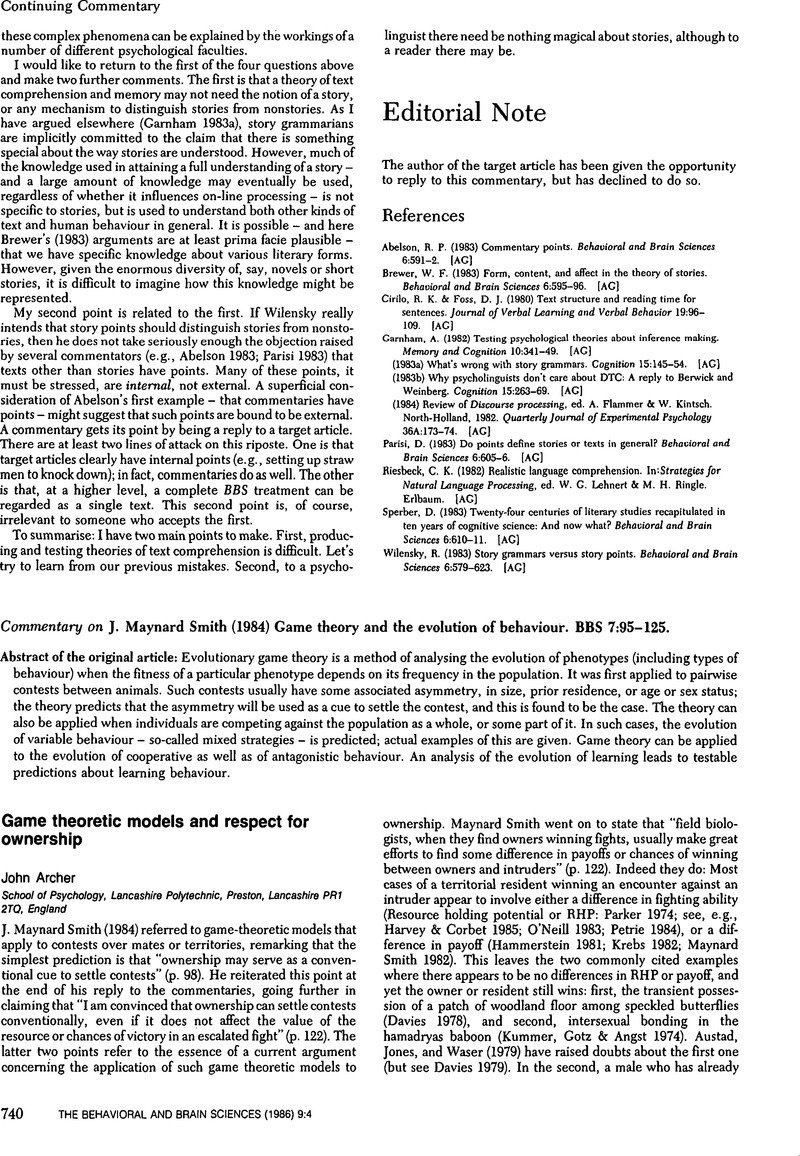No CrossRef data available.
Article contents
Ownership and honesty in competitive interaction
Published online by Cambridge University Press: 04 February 2010
Abstract
An abstract is not available for this content so a preview has been provided. Please use the Get access link above for information on how to access this content.

- Type
- Author's Response
- Information
- Copyright
- Copyright © Cambridge University Press 1986
References
Austad, S. N., Jones, W. T. & Waser, P. M. (1979) Territorial defence in speckled wood butterflies: Why does the resident always win? Animal Behaviour 27:960–61. [JA]CrossRefGoogle Scholar
Bishop, D. T., Cannings, C. & Maynard Smith, J. (1978) The war of attrition with random rewards. Journal of Theoretical Biology 74:377–88. [JA]CrossRefGoogle ScholarPubMed
Davies, N. B. (1978) Territorial defence in the speckled butterfly (Pararge aegerio): The resident always wins. Animal Behaviour 26:138–47. [JA]CrossRefGoogle Scholar
Davies, N. B. (1979) Game theory and territorial behaviour in speckled wood butterflies. Animai Behaviour 27:961–62. [JA]CrossRefGoogle Scholar
Davies, N. B. & Houston, A. I. (1984) Territory economics. In: Behavioural ecology, 2nd edition, ed. Krebs, J. R. & Davies, N. B.. Blackwell. [rJMS]Google Scholar
Emlen, S. T. (1978) Cooperative breeding. In: Behavioural ecology, ed. Krebs, J. R. & Davies, N. B.. Blackwell. [AZ]Google Scholar
Enquist, M. (1984) Game theory studies on aggressive behaviour. Doctoral thesis, University of Stockholm. [RJMS]Google Scholar
Fisher, R. A. (1930) The genetical theory of natural selection. Oxford University Press. [AZ]CrossRefGoogle Scholar
Hammerstein, P. (1981) The role of asymmetries in animal conflicts. Animal Behaviour 29:193–205. [JA]CrossRefGoogle Scholar
Harvey, I. F. & Corbet, P. S. (1985) Territorial behaviour of larvae enhances mating success of male dragonflies. Animal Behaviour 33:561–65. [JA]CrossRefGoogle Scholar
Hildrew, A. G. & Townsend, C. R. (1980) Aggregation, interference and foraging by larvae of Plectrocnemia conspersa (Trichoptera: Polycentropodidae). Animal Behaviour 28:553–60. [JA]CrossRefGoogle Scholar
Hyatt, G. W. & Salmon, M. (1979) Combat in the fiddler crabs. Uca pugilator and U. pugnax: A quantitative analysis. Behaviour 65:182–211. [JA]CrossRefGoogle Scholar
Kirkpatrick, M. (1986) The handicap mechanism of sexual selection does not work. American Naturalist 127:222–40. [rJMS]CrossRefGoogle Scholar
Krebs, J. R. (1982) Territorial defence in the great tit (Parus major): Do residents always win? Behavioral Ecology and Sociobiology 11:185–94. [JA]CrossRefGoogle Scholar
Kummer, H., Gotz, W. & Angst, W. (1974) Triadic differentiation: An inhibitory process protecting pair bonds in baboons. Behaviour 49:62–87. [JA]CrossRefGoogle ScholarPubMed
Maynard Smith, J. (1974) The theory of games and the evolution of animal conflicts. Journal of Theoretical Biology 47:209–21. [JA]CrossRefGoogle Scholar
Maynard Smith, J. (1976a) Evolution and the theory of games. American Scientist 64:41–45. [JA]Google Scholar
Maynard Smith, J. (1976b). Sexual selection and the handicap principle. Journal of Theoretical Biology 57:239–42. [rJMS, AZ]CrossRefGoogle Scholar
Maynard Smith, J. (1982) Evolution and the theory of games. Cambridge University Press. [JA]CrossRefGoogle Scholar
Maynard Smith, J. (1984) Game theory and the evolution of behaviour. Behavioral and Brain Sciences 7:95–101. [JA, AZ]CrossRefGoogle Scholar
Maynard Smith, J. (in press) Sexual selection, handicaps, and true fitness. Journal of Theoretical Biology. [rJMS]Google Scholar
O'Neill, K. M. (1983) The significance of body size in territorial interactions of male beewolves (Hymenoptera: Sphecidae, Philanthus). Animal Behaviour 31:404–11. [JA]CrossRefGoogle Scholar
Packer, C. & Pusey, A. E. (1982) Cooperation and competition between coalitions of male lions: Kin selection or game theory? Nature 296:740–42. [rJMS]CrossRefGoogle Scholar
Parker, G. A. (1974) Assessment strategy and the evolution of fighting behaviour. Journal of Theoretical Biology 47:223–43. [JA]CrossRefGoogle ScholarPubMed
Parker, G. A. & Rubenstein, D. I. (1981) Role assessment, reserve strategy, and acquisition of information in asymmetric animal conflicts. Animal Behaviour 29:221–40. [JA]CrossRefGoogle Scholar
Petrie, M. (1984) Territory size in the moorhen (Gallinula chloropus): An outcome of RHP asymmetry between neighbours. Animal Behaviour 32:861–70. [JA]CrossRefGoogle Scholar
Riechert, S. E. (1978) Games spiders play: Behavioral variability in territorial disputes. Behavioral Ecology and Sociobiology 3:135–62. [JA]CrossRefGoogle Scholar
Riechert, S. E. (1979) Games spiders play II: Resource assessment strategies. Behavioral Ecology and Sociobiology 6:121–28. [JA]CrossRefGoogle Scholar
Sigg, H. & Falett, J. (1985) Experiments on respect of possession and property in hamadrayas baboons (Papio hamadryas). Animal Behaviour 38:978–84. [rJMS, JA]CrossRefGoogle Scholar
Suter, R. & Keiley, M. (1984) Agonistic interactions between male Frontinella pyramitela (Araneae, Linyphiidae). Behavioral Ecology and Sociobiology 15:1–7. [JA]CrossRefGoogle Scholar
Trivers, R. L. (1974) Parent offspring conflict. American Zoologist 14:249–64. [AZ]CrossRefGoogle Scholar
Williams, G. C. (1966) Adaptation and natural selection: A critique of some current evolutionary thoughts. Princeton University Press. [AZ]Google Scholar
Zahavi, A. (1975) Mate Selection - a selection for a handicap. Journal of Theoretical Biology 53:205–14. [JMS. AZ]CrossRefGoogle ScholarPubMed
Zahavi, A. (1976) Cooperative nesting in Eurasian birds. In: Proceedings of the 16th international ornithology congress, ed. Frith, J. H. & Calaby, J. H.. Canberra, Australia. [AZ]Google Scholar
Zahavi, A. (1977) Reliability in communication systems and the evolution of altruism. In: Evolutionary ecology, ed. Stonehouse, B. & Perrins, C. M.. University Park Press. [rJMS, AZ]Google Scholar
Zahavi, A. (1981) Natural selection, sexual selection and the selection of signals. In: Evolution today, ed. G. C. E., Scudder & J. L. Reveal. Proceedings of the 2nd International Congress of Systematic and Evolutionary Biology.Google Scholar


